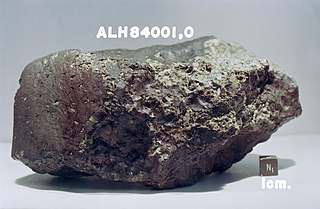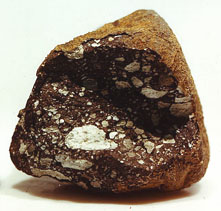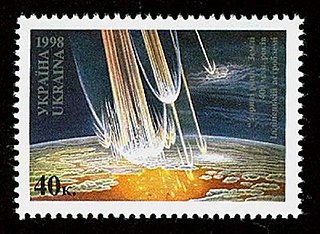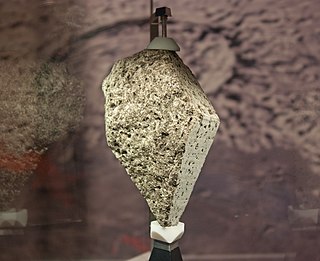This is a list of lunar meteorites . That is, meteorites that have been identified as having originated from Earth's Moon.
Contents
| Meteorite | Found | Mass (g) | Notes |
|---|---|---|---|
| Lahmada 020 | 2018 | 12170 | feldspathic breccia |
| Yamato 791197 | 1979 | 52 | feldspathic regolith breccia |
| Yamato 793169 | 1979 | 6 | mare basalt |
| Yamato 793274/981031 | 1980–1999 | 195 | anorthosite-bearing basaltic regolith breccia [1] |
| ALH A81005 | 1981 | 31 | feldspathic regolith breccia; FIRST RECOGNISED LUNAR METEORITE |
| Yamato 82192/82193/86032 | 1983–1986 | 712 | feldspathic fragmental breccia |
| EET 87521/96008 | 1987–1996 | 84 | basaltic or gabbroic fragmental breccia |
| Asuka 881757 | 1988 | 442 | mare basalt, "ortho" cumulate |
| MAC 88104/88105 | 1989 | 724 | feldspathic regolith breccia |
| Calcalong Creek | ~1990 | 19 | basalt-bearing feldspathic regolith breccia |
| QUE 93069/94269 | 1993–1994 | 24 | feldspathic regolith breccia |
| QUE 94281 | 1994 | 23 | anorthosite-bearing basaltic regolith breccia |
| Dar al Gani 262/996 | 1997–1999 | 525 | feldspathic regolith breccia |
| Dar al Gani 400 | 1998 | 1425 | feldspathic regolith breccia |
| Dhofar 081/280/910/1224 | 1999–2003 | 572 | feldspathic glassy-matrix fragmental breccia |
| NWA 5000 | 1999 | 11500 | feldspathic breccia |
| Yamato 983885 | 1999 | 290 | basalt-bearing feldspathic regolith breccia |
| Kalahari 008/009 | 1999 | 14100 | feldspathic regolith breccia & basaltic fragmental breccia |
| NWA 032/479 | 1999–2001 | 456 | mare basalt |
| unnamed | 2000 | feldspathic regolith breccia | |
| Northwest Africa (NWA) 482 | 2000? | 1015 | feldspathic impact-melt breccia |
| Dhofar 025/301/304/308 | 2000 | 772 | feldspathic regolith breccia |
| Dhofar 026/457/458/459/460/461/462/463/464/465/466/467/468 | 2000–2001 | 709 | feldspathic granulitic breccia |
| NEA 003 | 2000–2001 | 124 | mare basalt with basaltic impact-melt breccia |
| NWA 773/2700/2727/2977/3160/3333? | 2000–2005 | 1156 | complex fragmental and regolith breccia consisting of basalt and cumulate olivine gabbro |
| Dhofar 287 | 2001 | 154 | mare basalt with regolith breccia |
| Dhofar 302 | 2001 | 4 | feldspathic impact-melt breccia |
| Dhofar 303/305/306/307/309/310/311/489/730/731/908/909/911/950/1085 | 2001–2003 | 1037 | feldspathic impact-melt breccia |
| Dhofar 490/1084 | 2001–2003 | 124 | feldspathic fragmental breccia |
| MET 01210 | 2001 | 22.8 | anorthosite-bearing basaltic regolith breccia |
| Dhofar 733 | 2002 | 98 | feldspathic granulitic breccia |
| Northeast Africa (NEA) 001 | 2002 | 262 | feldspathic regolith breccia |
| SaU 169 | 2002 | 206 | KREEP-rich, mafic impact-melt breccia & regolith breccia |
| LAP 02205/02224/02226/02436/03632/04841 | 2002–2005 | 1930 | mare basalt |
| PCA 02007 | 2003 | 22 | feldspathic regolith breccia |
| Dhofar 925/960/961 | 2003 | 106 | basalt-bearing feldspathic impact-melt breccia |
| NWA 2200 | 2004 | 552 | feldspathic impact-melt breccia |
| unnamed | 2004 | 24.2 | feldspathic breccia |
| SaU 300 | 2004 | 153 | basalt-bearing feldspathic regolith breccia |
| NWA 3136 | 2004 | 95 | anorthosite-bearing basaltic regolith breccia |
| NWA 3163 | 2005 | 1634 | feldspathic granulitic breccia |
| Dhofar 1180 | 2005 | 115 | basalt-bearing feldspathic fragmental or regolith breccia |
| NWA 2995 | 2005 | 538 | basalt bearing feldspathic fragmental breccia |
| MIL 05035 | 2005 | 142 | mare basalt |
| unnamed | 2005 | 26 | |
| unnamed | 2005 | 68 | mare basalt |
| Dhofar 1428 | 2006 | 213 | feldspathic impact-melt breccia |
| unnamed | 2006 | 18.7 | feldspathic breccia |
| NWA 2998 [provisional] | 2006 | 183 | feldspathic breccia |
| NWA 4472/4485 [provisional] | 2006 | 185 | |
| Shisr 162 (Shişr 162) | 17 Feb 2006 | 5525 | feldspathic breccia [2] |
| Anoual | 2006 | 5.9 | Found in Morocco [3] |
| Aridal 017 | 2016 | 590 | Found in Morocco [4] |
| AaU 012 | 2012 | 122.8 | Abar al' Uj 012, Saudi Arabia [5] |
| NWA 10309 | 2015 | 16520 | feldspathic breccia. Largest known lunar meteorite as of October 2018 [update] . [6] |
| NWA 11789 | 2017 | 5492 | feldspathic breccia |
| NWA 11228 | 2017 | 140 | feldspathic breccia [6] |
| NWA 14685 | 2020 | 8000 | fragmental breccia |
| NWA 11444 | 2017 | 1323 | melt breccia [7] |
| NWA 11182 | 2017 | 60 | feldspathic breccia |










